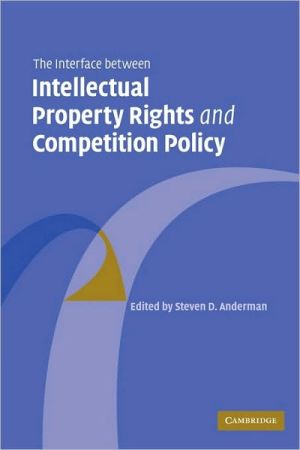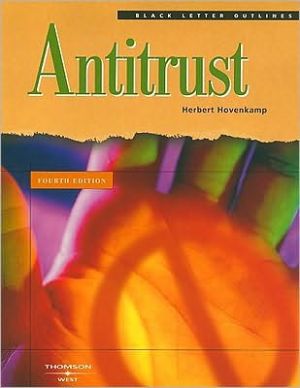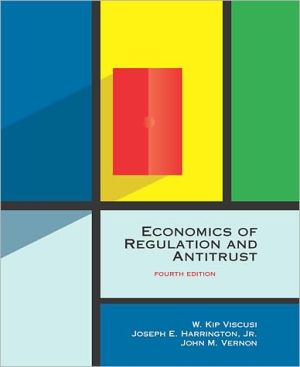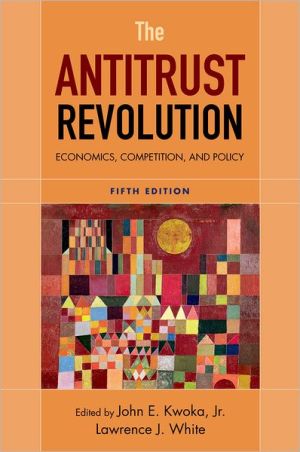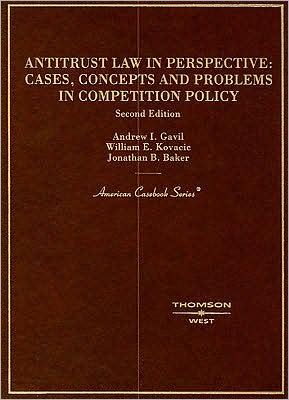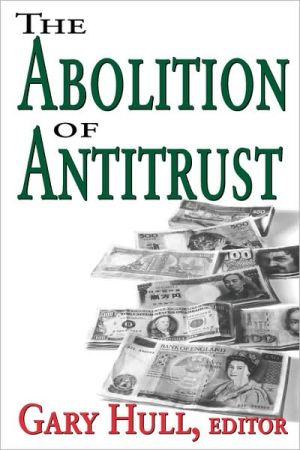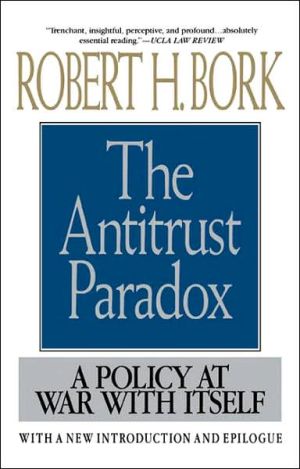The Interface Between Intellectual Property Rights and Competition Policy
The purpose of this book is to examine the experience of a number of countries in grappling with the problems of reconciling the two fields of competition policy and intellectual property rights. The first part of the book indicates the variation in legislative models as well as the wide variety of judicial and administrative doctrines that have been used. The jurisdictions selected for study are the three major trading blocks with the longest experience of case law - the EU, the USA and...
Search in google:
Various legal systems approach the problems raised at the interface between IPRs and competition law.
Cambridge University Press\ \ 9780521863162 - The Interface between Intellectual Property Rights and Competition Policy - Edited by Steven D. Anderman\ \ Excerpt\ \ \ \ \ \ \ 1 The competition law/IP ‘interface’: an introductory note\ STEVEN D. ANDERMAN\ I. Introduction\ Competition policy and intellectual property rights (IPRs) have evolved historically as two separate systems of law. Each has its own legislative goals and each its own methods of achieving those goals. There is a considerable overlap in the goals of the two systems of law because both are aimed at promoting innovation and economic growth.1 Yet there are also potential conflicts owing to the means used by each system to promote those goals. IP laws generally offer a right of exclusive use and exploitation to provide a reward to the innovator, to provide an incentive to other innovators and to bring into the public domain innovative information that might otherwise remain trade secrets. Competition authorities regulate near monopolies, mergers and commercial agreements with the aim of maintaining effective competition in markets. This regulation occasionally results in limits being placed on the free exercise of the exclusive rights granted by IP laws.\ In recent decades, competition authorities and courts have prohibited conduct by intellectual property owners which was otherwise lawfulunder intellectual property rights legislation, because it contravened the rules of competition law. This has occurred in four main spheres of activity of IP owners. First, cases have been brought by the competition authorities in the USA, the EU and Japan to place limits on the anticompetitive commercial conduct of individual owners of IPRs where they protect a market standard or de facto monopoly.2 The competition issue presented in these cases has generally been the IP owner’s exclusionary conduct towards innovators and potential competitors on markets which are secondary to and dependent upon an IPR protected industrial standard or de facto monopoly. The anticompetitive conduct has tended to take the form of a ‘refusal to deal’, ‘refusal to license’, ‘refusal to provide proprietorial software interface codes’, or a ‘tie-in’ or illegal ‘bundling’, but the act is prohibited because it is viewed as an attempt to ‘lever’ the IP reinforced market power in the ‘primary’ market into exclusionary conduct in the secondary market.3 Secondly, the competition authorities in the USA, the EU and Japan have created a detailed framework of regulation for certain terms of bilateral IPR licensing agreements, whether by means of official guidelines or legislation. Thirdly, the practices of collecting societies, R&D agreements and patent and technology pools have raised the issue of the appropriate treatment of cooperation between competitors in IP related fields under the competition rules. Finally, in the field of mergers and acquisitions, the owners of intellectual property rights have found that competition authorities have intervened on occasion to limit IPR owners from acquiring competing technologies4 as well as to require compulsory licences of IPRs to third parties as a condition of merger approval.\ As modern commercial practices involving the use of intellectual property rights have encountered these forms of ‘second tier’ regulation by competition authorities, concerns have been raised about the nature of the accommodation between the two systems of law.5 First, to what extent and on what basis do the competition authorities and the courts have authority to limit the exercise of intellectual property rights in these ways? If IPRs are granted by laws which have their own elaborate system of checks and balances, why is it necessary for competition law to add a second layer of legal regulation to the exercise of IPRs? It appears as if the competition authorities in a number of jurisdictions take the view that their role is a form of public law regulation while the exercise of an IPR is essentially the exercise of a private property right. Certainly, in the USA and the EU, the competition authorities have at times described IPRs as ‘essentially comparable’ to any other form of private property for the purposes of the competition rules.6 To what extent do legislation and judicial decisions support the competition authorities in that view?\ Secondly, despite the use of this description, when competition law is actually applied to the exercise of IPRs, in these same jurisdictions, concessions are often consciously made within the competition rules to the unique nature of intellectual property rights: to their legislative and, in the USA, their constitutional basis as well as to their contributory role in the process of innovation. Indeed, the compatibility between the aims of the two systems tends to ensure that the normal exercise of the prerogatives of intellectual property rights is consistent with the competition rules. The competition rules applied to IPRs, either explicitly or implicitly, almost inevitably acknowledge a form of ‘comity’ between the two systems of law. Yet, the forms of comity developed within the competition rules in different legal system have tended to differ from system to system.\ A third issue raised by the emergence of an extra layer of regulation of IPRs by the competition authorities is to what extent could and should the various IPR laws themselves, the patent, copyright, and design rights laws be reformed in order to reduce the extent of the ‘external’ regulatory role now played by competition law. To what extent does the experience of interface cases suggest that the IP laws can enhance the nature and degree of comity by embarking upon a process of ‘internal’ reform? Some issues of reform that have been considered are: (i) the optimum width and duration of patent and copyright protection; (ii) the issue whether industrial copyright laws should provide for compulsory licensing where innovation is improperly obstructed by IP owners along lines similar to patents; (iii) the extent to which industrial copyright such as software programs and databases should be subject to interoperability obligations under IP law; and (iv) the extent to which IP laws can and should acknowledge when the IPR itself creates a monopoly and place limits on the scope of the IP protection. Underlying these enquiries is perhaps the largest policy issue of all: what is the most appropriate relationship between competition policy and IPRs in a growing industrial economy?\ If we look at the major legal systems with extensive experience of the coexistence of the two fields of law, the EU, the USA and Japan, we can see considerable variation in their chosen forms of accommodation. The major legal systems have generally accepted that there are cases where the market maintenance concerns of competition law can prevail over the exercise of IPRs associated with substantial market power. However, the nature of this accommodation varies considerably with each system; both in terms of method and where the line is drawn. Moreover, the experience of these countries makes it plain that the true extent of variation cannot be appreciated by a cursory examination. To see it clearly and accurately requires a look in some depth. For example, in Japan, at first sight its competition law gives an extensive legislative immunity to intellectual property rights; the Japanese Antimonopoly Act exempts intellectual property rights from the scope of its application. Yet, on closer examination, the provision has not been interpreted as an overall exemption to all exercises of intellectual property rights but can be limited in cases of private monopolisation or undue restraint of trade (See Chapter 4). In the EU and US, in contrast, there are no explicit legislative immunities in the competition rules of Articles 81 and 82 of the European Treaty or Sections 1 and 2 of the Sherman Act. Instead, the general competition rules in both legal systems have been given judicial and administrative interpretations that result in their application to the exercise of IPRs in extreme cases. Both systems have created wide general norms of competition law which if not modified can apply to limit the exercise of IPRs. Yet, on closer examination, the application of the general competition rules in the US and the EU has resulted in the evolution of judicial and administrative doctrines which apply special rules and even self-denying ordinances acknowledging to a considerable extent the sui generis nature of IPRs, their constitutional foundations in the USA and their legislative foundations in the EU. Sometimes these forms of comity are given expression in special rules explicitly designated for IPRs. One example is offered by the ‘exceptional circumstances’ test devised by the European Court of Justice when applying Article 82 to an issue of abusive refusal to licence by an IP owner. More often, there are powerful partial immunities or safe havens built into the logic of the general competition rules when they are applied to the acts of the conduct of the IP owner. Often this is the logical outcome of the two systems of law pursuing similar aims. For example, both US and EU competition law make it clear that if a company grows by internal investment in R&D and IPRs to a position of significant market power that is perfectly lawful under the competition rules. Moreover, if the owners of IPRs wish to charge high prices for their successful products protected by IPRs, the risks of investment ex ante will be respected by the competition rules in each legal system albeit in different ways. The normal exercise of IPRs is by judicial doctrine viewed as lawful under the competition rules but each system has its own line where the exercise of an intellectual property right is not viewed as normal under the competition rules.\ The purpose of this book is to examine the experience of a number of countries in grappling with the problems of reconciling the two systems and dealing with interface issues. The book is divided into three parts. The first two parts of the book indicate the variation in legislative models as well as the wide variety of judicial and administrative doctrines that have been used to attempt to deal with problems raised at the interface between intellectual property rights and competition law. The jurisdictions selected for study are the three major trading blocks with the longest experience of case law: the EU (Chapter 2), the USA (Chapter 3) and Japan (Chapter 4) and three less populous countries with open economies, Australia (Chapter 5), Ireland (Chapter 6) and Singapore (Chapter 7).\ In these parts, the intent is not to attempt to arrive at a definitive model of reconciliation between the systems of legal regulation or even a recommended ‘best practice’. The examination in depth of the different jurisdictions makes it plain that each system must determine its own appropriate accommodation. It is true that recently, efforts have intensified in different jurisdictions to find the most appropriate basis upon which to combine the two policies into a coherent whole for the purposes of innovation policy. In the USA the Antitrust Division of the Department of Justice and the Federal Trade Commission have held extensive hearings on the interface issue.7 In the EU the Technology Transfer Block Exemption Regulation has recently been significantly reshaped and a series of conferences have been held with the aim of obtaining a clearer idea of the best way to apply competition law to the commercial exercise of intellectual property rights.8 In Australia the Intellectual Property Review Committee was established both to review IP laws from the standpoint of competition and to recommend a reform of the width of the exemption the Trade Practices Act gave to the exercise of intellectual property rights. In many countries with new competition laws which have already enacted IP legislation, such as India, China, Singapore and Hong Kong, there is a need to shape the overall system to deal with the inevitable conflicts that can arise when the exercise of IPRs runs into the buffers of the competition rules. Finally, in the USA, EU and Japan, the interest in the interface has been whetted by the growth of digital multi-media technology and the potential legal roadblocks in the new technological environment. Nevertheless, it seems almost inevitable that the optimum method of reconciliation will differ for each national system depending upon its legal culture and its state of economic development.\ Hence the overall aim of this book is the more modest one of setting out the array of options on offer, the legislative and judicial and administrative alternatives available in those constituencies with some experience of dealing with the interface. The intention is to produce research findings in sufficient depth so that the experience of the selected legal systems can be understood and used as points of reference by competition authorities and the parties involved in interface disputes. This is a research study that should be viewed as a reference work and a resource to be adapted to the particular circumstances of any one legal system.\ In the third part of the book we look at a number of issues closely related to the interface between competition law and intellectual property rights. Chapter 8 analyses the issue of parallel trading and exhaustion of IPRs, a system of legal rules that creates its own interface with the exercise of IPRs alongside the competition rules. Chapter 9 discusses the issue of technology transfer showing the important differences between international IP licensing and foreign direct investment as well as highlighting how limits on technology spillover are set in bilateral investment treaties. Finally, Chapter 10 examines the economics of the interface to suggest how economic thinking may find a way of interacting with legal argument in this field.\ II. A note on the compatibilities between the two systems of legal regulation\ Even without a legislative immunity for IPRs, the case law interpreting the competition legislation in the countries studied demonstrates that the competition rules create certain self-denying ordinances to ensure that there is an extensive reconciliation between the two systems of legal regulation. This is entirely to be expected since, within each legal system, the different means used by intellectual property rights legislation and competition law operate in many ways in conjunction rather than in conflict with each other. IP laws, such as patent and copyright laws, confer an exclusive right to exploit an invention or creation commercially for a limited period as an incentive to creation and innovation. These rights are essentially ‘negative’ rights; they prevent copying of the protected innovations. They do not ensure profitability but if the IPR is combined with a successful product, the legal exclusivity provides a stimulus to innovation by acting both as a reward to the inventor/creator and as an incentive to innovation more generally. In the case of patents, without the protection of exclusivity, firms may choose to keep their innovative ideas secret as opposed to disclosing them in their patent claims. This stimulus to the spread of information is also a stimulus to innovation resulting in new products and processes entering existing markets and creating new markets. In these ways, intellectual property rights can actually enhance the forces of competition.\ Moreover, each IP law, as well as competition policy, strikes its own balance between protecting early innovators and protecting the claims of ‘follow on’ innovators. IP laws, such as patent and copyright laws, strike an ‘internal balance’ between the rewards for ‘the improvements on earlier invention by later innovators’, and the rewards to ‘early innovators … for the technological foundation they provide to later innovators’.9 As Merges and Nelson have pointed out: ‘Ultimately it is important to bear in mind that every potential inventor is also a potential infringer. Thus a strengthening of property rights will not always increase incentives to invent; it may do so for some pioneers, but it will also greatly increase an improver’s chances of becoming enmeshed in litigation.’10 In copyright, the idea/expression dichotomy operates to ensure that copyright contributes to common knowledge while protecting the originator or creator from copying the expression of his or her work. In other words, IP laws usually attempt to strike a balance between providing sufficient incentives to innovation by the creator/inventor and avoiding the protection of any single innovation operating as a disincentive to cumulative ‘follow on’ innovation.\ At the same time, the basic doctrines of modern competition law work in conjunction with IP laws by acknowledging their positive role in the process of innovation in at least five major respects. First and foremost, both the US and the EU competition laws accept that the achievement of an economic monopoly by means of investment R&D and intellectual property rights is a legitimate course of conduct for a firm, a form of ‘competition on the merits’. Secondly, and relatedly, both EU competition law and US antitrust law acknowledge that the pricing of IPRs, even by dominant firms, must include a return which adequately reflects the reward/incentive function of IPRs as well as the ex ante investment risks of their owners. Thirdly, the competition laws in both systems in most cases give recognition to the right of IPR owners to prevent copying even if the exercise of this right denies access to markets to competitors. Fourthly, the competition laws in both systems no longer automatically assume that the legal monopoly conferred by IP laws, such as patent and copyright legislation, automatically amounts to an economic monopoly or even confers market power. That issue is left to be established empirically. Finally, in their analysis of IP licensing agreements both systems of competition policy work with the presumption that the licensing of IPRs is in general pro-competitive in its effects.\ Nevertheless, as we have seen, modern competition policy, does act in reserve to prevent the excesses of private property owners in order to maintain effective competition on, and access to, markets,11 operating as a ‘second tier’ of regulation of intellectual property rights.\ It is also worth noting that the Agreement on Trade Related Intellectual Property Rights (TRIPS) spells out at various points that there is a role for competition policy to supplement the intellectual property rights policy of the Treaty. In formal terms, it does not require such laws. It permits them. For example, Article 8 (2) TRIPS states that ‘Appropriate measures, provided they are consistent with the provisions of this Agreement, may be needed to prevent the abuse of intellectual property rights by right holders …’ Article 8 also makes it clear that in principle Member States may enact legislation to prevent practices by the right holder that adversely affect the international transfer of technology. Moreover, in Article 40, the TRIPS agreement specifies the types of licensing practices or conditions relating to intellectual property rights which restrain competition and impede the transfer and dissemination of technology including exclusive grant-back conditions, coercive package licensing and clauses preventing challenges to the validity of the IPR. Nevertheless, as this note and the following studies will show, it is wise not to have a system of IPR legislation which is unaccompanied by a system of competition law.\ III. The changing nature of the interface between the exercise of IPRs and competition policy in the major competition law systems\ From the early years of the twentieth century, the conflict between the exercise of IPRs and competition policy tended to be exaggerated by judicial and administrative doctrines initially in the USA and later in the EU. During these and later decades, patents were equated with monopolies12 and patent licensing was subject to tight restrictions by competition law, initially following a doctrine of patent misuse,13 and latterly by the regime of the ‘Nine No-Nos’ in the USA and its counterpart in the EU.14 Since the 1970s, a new antitrust legal framework has emerged in both trading blocks with a greater appreciation of the economic benefits of IPRs and a move away from any automatic association of real market power with exclusive IP rights.15 This change was prompted in part by judicial and administrative acceptance of the law and economics analysis of the ‘Chicago School’,16 initially in the USA and later in the EU. Yet the Chicago School’s initial success in restoring greater economic realism has been followed by a ‘post-Chicago School’ view emerging both in the USA17 and in the EU18 that acknowledges that not all IPRs are monopolies but recognises that some can be. There are cases where IP owned assets make a right holder dominant in a product market in established sectors of industry and such cases can be found not infrequently in the ‘new economy’, particularly in the copyright protected information technology, media and telecommunications sectors. Moreover, patent protected products and processes in the biotechnology sectors may also be potentially subject to the limits of this competition policy/intellectual property law interface.19\ The concern of competition authorities with IPR protected dominant market power in the form of industrial standards particularly in the sectors of the ‘new economy’ can be traced to two developments. First, there has been an unprecedented expansion of IPR protection to a whole new range of products in the knowledge economy.20 Existing protection regimes such as patent and copyright have been extended to accommodate new technology such as biotechnology in the EU Biotechnology Directive, and information technology in the new EU Copyright and Related Rights Directive for the Information Society, as well as the Digital Millennium Copyright Act in the USA. Copyright and patent protection have been extended to new areas such as computer software and business methods. Sui generis protection has been extended to databases and semiconductors.\ This expansion of functional coverage of IPRs in recent decades has been fuelled by an increased awareness in the US and EU of the role of intellectual property rights in information goods as a significant source of wealth creation and a basis for success in international competition21 as well as an increased concern to protect such informational rights against the ease of illegal copying of such goods.22 The arguments of certain scholars, particularly but not exclusively in the USA, for acceptance of a stronger ‘property rights’ conception of IPRs have contributed to a wider acceptance of this concept.23 During the last two decades, the US judiciary have made a number of decisions resulting in greater ease of obtaining patents24 and greater ease of enforceability of IPRs,25 as well as a wider view of protected subject matter in copyright.26 In the USA, a new Federal Court of Appeals specialising in patent and other IPR matters was established in the 1980s27 and during its period of tenure the number of patents granted in the USA has risen at a steep rate.28 The decisions favouring a wider IP protection over other balancing contentions have not been unanimous,29 but the accretion of landmark cases widening intellectual property protection in the USA have amounted to a noticeable judicial pattern, even if there are cases going the other way.30 By and large the EU has followed suit by widening its definitions of patentability and copyright, if not quite so extensively as the USA.31\ Along with this expansion of their functional coverage, IPR protection regimes have also been extended geographically as minimum standards through the medium of the TRIPS agreement within the framework of the World Trade Organisation (WTO). The impetus for this globalisation of IPR legislation has come from the large IP owning corporations wishing to protect their investments in R&D from copying, particularly in developing countries with weaker IP legislation. The emergence of TRIPS has been described as ‘a process whereby the wish lists of various intellectual property lobby groups are inscribed into public international law’.32 In the 1980s, the US Government brought IP protection within the GATT and used its s. 301 procedure to obtain bilateral agreements to protect US IPRs. By 1993, the USA, supported by the EU and Japan, was able to secure a TRIPS agreement as part of the WTO agreement of 1994. These highly developed countries had accepted the economic arguments that the return to such investments by the larger corporations helped to maintain the growth and development of their economies in the face of world competition.33 The TRIPS agreement imposes high minimum standards34 upon its members for all forms of IPRs based on the Berne and Paris Conventions as well as most of the rights.\ The second development, particularly in the highly industrialised countries, is that the expansion of IPR protection, along with its increased incentives for R&D investment, has also produced certain risks to cumulative innovation in the high technology sectors. There has been a noticeable tendency for particular markets in the USA, EU and Japan to be characterised by individual market leadership reinforced by IPR protected industrial standards.35 The phenomenon of a product achieving such a market position normally calls for careful monitoring by the competition authorities.36 The risks from a competition policy point of view arise from the possibility that the market power inherent in a market standard might be abused to preclude access to downstream related markets. In such situations, the owner of the ‘system’ which has achieved the status of an IP protected industrial standard tends to look proprietorially at the development of improvements and new products relating to the ‘system’. As Ordover and Willig put it, in a situation where the incumbent market leader has high sunk investments and is confronted by risks of leaks to free-riding competitors, there is a tendency to look more closely at a strategy of capitalising on vertical integration to develop modular applications related to the market standard.37 In the recent US Microsoft case, for example, the Federal District Court that tried the case accepted that the market share of the Windows operating system was 94 per cent of all Intel chip PCs worldwide. In respect of modular applications, MS Word had fended off Word Perfect to gain about 90 per cent of the word processing market and Microsoft’s Internet Explorer had captured more than 80 per cent of the web browser market from the previously dominant Sun Microsystem’s Netscape Navigator (50 per cent).38\ It is true that some vertical business strategies can, on balance, be pro-competitive where they are based on genuinely innovative products.39 Moreover, they can help to create and maintain useful industrial standards in related markets. Yet, in network industries where the incumbent enjoys a monopoly, with substantial ‘network effects’ and a large installed base of users, the possibility of anticompetitive strategies cannot be ruled out.40 Similarly, where a base product such as a biotechnological patent gets into a strong position to control follow-on research and development of related products, competition concerns may arise.41\ The strategies of owners of IPR protected industrial standards can take the form of vertical foreclosure by exclusive contracts, the tying-in of one product with the sale of another, or ‘bundling’, and refusals to deal or license, all means by which the owner of the industrial standard can lever its monopoly on an upstream market into a monopoly on the downstream/dependent market.\ The vertical foreclosure of downstream markets by owners of industrial standards in upstream markets entails two risks to innovation. The main risk is that the process of further innovation will be restricted to the R&D of the owner of the upstream industrial standard and thereby deprive a wider circle of developers from contributing to the next stages of innovation.42 A second risk is that the ‘network effects’ barrier to entry can result in technologically inferior products ‘tipping’ certain downstream markets and technologically superior products being lost.43\ Some economists, such as Schmalensee and Evans, have objected to this type of competition concern claiming that the process of competition in markets in the new economy is different in kind to that in the old because it takes the form of different technological systems competing for the market rather than the traditional form of competition in the market.44 Competition in high technology markets, they say, consists of a rivalry between products designed to replace one another rather than remain in competition in the same market and these forces make monopolies fragile and transitory.45 They describe this form of competition as ‘dynamic competition’, or ‘Schumpeterian’ competition, because it involves a process of ‘creative destruction’ which strikes ‘not at the margins of the profits of existing firms but their foundations and their very lives’.46 There has even been a suggestion that these forces of competition can make markets self-regulating.47 In the IT field there is undoubtedly some evidence of dynamic competition, i.e. succeeding generations of products achieving industrial standard status only to disappear and be replaced by competitors: Wang and dedicated word processors gave way to CP/M and Wordstar. Wordstar in turn was ousted by MSDOS/Word Perfect and Lotus 1-2-3, which in turn was displaced by MS Windows, MS Word and MS Excel, etc.48\ It is misleading, however, to portray copyright and patent protected industries as presenting a picture of endless winner-take-all races.49 In the first place, we can see a pattern of protracted competition between IP protected products in systems in a number of highly concentrated industrial sectors: mobile telephones, computer games, PC hardware, ISPs on the Internet, pay TV, motion pictures and music recordings.50 In these sectors, there is still competition, albeit reduced to a few suppliers, between firms in\ \ \ © Cambridge University Press
Notes on contributors viiPreface xiThe competition law/IP 'interface': an introductory note Steven D. Anderman 1Intellectual property rights and competition law in the major trading blocks 35EC competition policy and IPRs Steven D. Anderman Hedvig Schmidt 37Competition policy and its implications for intellectual property rights in the United States Rudolph J. R. Peritz 125The interface between competition law and intellectual property in Japan Christopher Heath 250Intellectual property rights and competition law in smaller and medium sized open economies 313Intellectual property rights and competition in Australia Frances Hanks 315Irish competition law and IP rights Imelda Maher 348The interface between intellectual property law and competition law in Singapore Burton Ong 375Issues related to the interface between intellectual property rights and competition law 427Parallel imports Miranda Forsyth Warwick A. Rothnie 429Technology transfer Rohan Kariyawasam 466The relationship between intellectual property law and competition law: an economicapproach Pierre Regibeau Katharine Rockett 505Index 553
